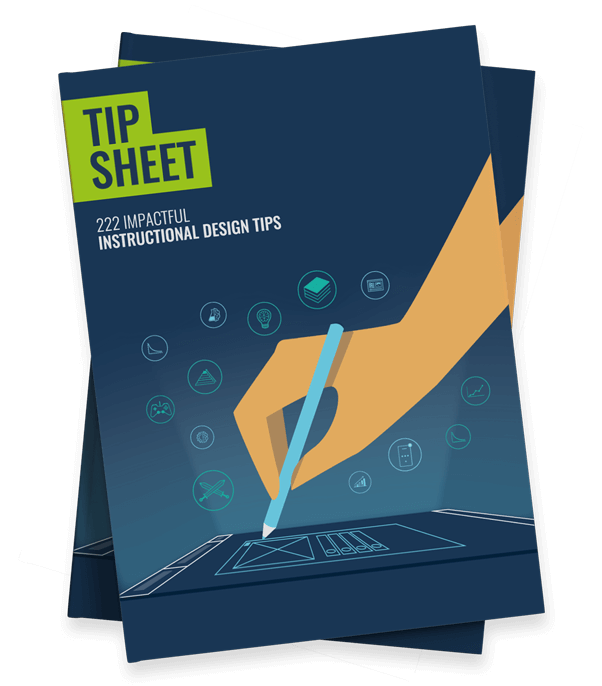We’ve all heard the saying: ‘think outside the box’. But have you ever stopped to consider the meaning behind this phrase and why it’s something to aim for?
And who’s there to consider what outside-the-box thinking means for the world of learning and development?
Us, that’s who!
In this article, we’ll explore the meaning behind the phrase ‘think outside the box’. We’ll also look at how you can apply this approach to your training initiative, successful examples of outside-the-box thinkers and more!
Ready? Let’s open the box and get started!
The Origin of the Phrase: ‘Think Outside the Box’?

The origin of the phrase ‘think outside the box’ is commonly debated. However, many believe it can be traced back to a simple puzzle.
Henry Ernest Dudeney was a mathematician from the early 20th century. He created a puzzle that asks you to connect nine dots on a three-by-three grid with only four straight lines.
But here’s the rub: you have to do it without the pencil leaving the page. Give it a go! The solution can be found here.
The experiment was popularised later in the 1970s by psychologist Joy Paul Guilford. He was one of the first psychologists to study creativity. As you can imagine, people had to think quite creatively in order to solve the puzzle.
The layout of the puzzle caused people to see an imaginary square, which made it difficult to solve. Only 20% of participants saw beyond this imaginary box and drew in the white space around the dots.
Hence, the popularisation of the phrase we know and love today!
What’s the Meaning Behind The Phrase ‘Think Outside the Box’?
Sometimes, we can get pretty stuck in our ways. We just go through the motions, doing what we need to but no more. We can get scared to deviate from the set route and make our own paths.
A lot of the time we’re not even really present in what we’re doing — we’re on auto-pilot. That’s not just a metaphor either.
Researchers at the Max Planck Institute for Human Development discovered that the anatomical structure of the brain has a built-in auto-pilot setting. They call this the ‘default mode network’.
This means that neuronal activity naturally switches to this resting state whenever there are no external influences on the brain.
In this respect, the brain is a very efficient piece of kit. But, it’s all too easy to drift into this safe-and-steady mode a little too often. Ever arrived back from work and not been able to remember the drive home?
Simply put, ‘thinking outside the box’ means letting go of the mental constraints or default ways of reasoning we’ve boxed ourselves in, and freeing ourselves to embrace new or innovative ways of thinking.
What Happens When We Think Outside the Box?
In order to get creative and think outside the box, a few things need to occur in our brain. First and foremost, it’s important to note that we have more than one creative hub. We actually have four:

- The Frontal Cortex: This is what we know as the main centre for creativity. This is because it plays a key role in a lot of the functions that stimulate creativity, such as short-term memory.
- The Hippocampus: We love the hippocampus function here at Growth Engineering! It’s the part of your brain responsible for memory storage and recall.
Research with amnesia patients shows that when the hippocampus is damaged, we not only have problems recalling the past but imagining the future.
As such, make sure to take good care of your hippocampus. It’s an essential part of generating all your ingenious ideas.
- The Basal Ganglia: This group of subcortical nuclei lies deep inside the brain. It’s responsible for processing your memory of skills and enabling us to perform actions. As a result, when we continuously repeat creative skills, we get better at them.
The basal ganglia helps with processes that we don’t have to actively recall. These are automated activities that just come to you in the moment. Consider, for instance, the phrase, ‘it’s just like riding a bike!’
- White Matter: This makes up the large network of neural fibres (axons) that connect different areas of our brains. The better connected these areas are, the faster you can process information.
As a result, you’re able to link together various pieces of information quicker and really get those creative juices flowing.
So, how can we get these areas working in harmony and producing ‘outside the box’ ideas? Let’s take a look!
How to Boost Creativity in the Brain

Some research suggests that how creative you are depends on your genetic background. Others believe that it’s a mix of genetics and experience.
Regardless of which is true, if you’ve reached a mental block, there are a few things you can do to encourage your brain to think outside the box.
Studies have shown that taking a break to let your mind roam is great in this situation. It often leads to an ‘aha’ moment and allows you to overcome an impasse.
Another thing you can do is simply observe others. Learning from others can often be a valuable source of inspiration.
For example, in a study, scientists noted that mirror neurons would fire as one monkey watched the actions of another. They were able to ‘mirror’ the actions of the other primate just by watching.
Studies have revealed that we possess neurons with similar properties. Additionally, a recent study found that creative parents often have creative one one-year-olds.
This goes to show, if we watch someone get creative, we’re likely to turn this social information into inspiration..
Lastly, some good old fashioned research will often do the trick. It can be useful to see how others have approached a problem and how they resolved it.
You’ll often learn what you can do and what not to do. We’re very lucky to live in a digital age. There’s a huge variety of media available for you to draw answers from!
Why Should We Think Outside the Box?
As we’ve said, thinking outside the box means approaching difficulties in different ways. Let’s look at a real life example.
Say you’re trying to bake bread by following a recipe. Unfortunately, it’s just not going right. You’ve followed the recipe to the letter and it worked in the past, but not today.
You’re getting frustrated, wondering what’s wrong with the recipe, or with your skills. Maybe you’ve resorted to blaming the nearest person!
When you think outside the box, you’re more likely to discover the real cause of the failure. “If it’s not me, not the ingredients and not the recipe, what else could be the matter?” you ask yourself.
“Ah! Of course. When I made the bread before, it was summer. Now it is winter and my house is a lot colder. No wonder the dough isn’t rising as quickly as it should!”
It’s simple, really. And now you’re armed with this new information, you’ll be ready to exercise patience and give your creation a bit longer to rise.
If we think outside the box as often as we can, there are a multitude of benefits. These include a wider perspective, higher-quality work and increased problem-solving abilities!
These are great skills to have in your arsenal, especially in the workplace.
Thinking Outside the Box in the Workplace

You should be ready to ‘think outside the box’ at any moment. You may be resistant to do so in a corporate environment, but this is often the key to success.
If we come across a really tricky problem, like a technical issue that we just can’t get our heads around, being stuck in a linear mindset can really set us back.
We end up banging our heads against a brick wall hoping to find a way through. But that just leaves us with an almighty headache.
On the other hand, if we think outside the box and come at the problem from a different angle, we can often find the solution we’ve been looking for.
It also helps to brainstorm ‘out there’ ideas with your colleagues. The father of the brainstorming method, Alex Osborn, found it can improve creativity by up to 50%!
Nowadays, it’s crucial for companies to think outside the box in order to differentiate themselves. Let’s go over some examples of companies that have successfully achieved this!
Business Examples of Thinking Outside the Box
1. Netflix
Did you know that Blockbuster had the opportunity to buy Netflix for $50 million? Unfortunately, their resistance to thinking outside the box cost them their future.
As of November 2022, Netflix has a whopping market cap of $126.85 billion. But how did they achieve this?
Netflix successfully took advantage of the huge technological advances we saw at the start of the 21st century. The founders heard of a new data storage format called a DVD. They realised that these discs would soon replace renting VHS tapes as the home viewing standard.
After various iterations, Netflix eventually created an unprecedented business model. This was a subscription-based service with no due dates or late fees and unlimited access to content at an affordable price.
Nowadays, they focus solely on streaming. They have created hundreds of original shows and movies and have over 200 million subscribers worldwide!
2. Corteiz (aka. Crtz)
This brand was created in 2017 from the founder’s bedroom. At first, they focused on producing screen-printed sweaters and t-shirts. Each item featured the now highly-recognisable Alcatraz logo.
Before long, they had created a clear brand identity: rebellion against the conventional.

This is a clothing business that uses no traditional marketing methods. It operates solely through social media and word of mouth.
Amazingly, their clothing releases sell out within minutes and resale prices are often at a 10x markup.
The brand focuses on rarity and exclusivity. The Corteiz website can only be accessed if you have the right password at the right time.
Additionally, the founder, ‘Clint’, will sometimes post a location where he’ll be selling a few select items that day. This has led to groups of young people running around London attempting to get their hands on a Corteiz piece!
Ultimately, Corteiz’s ability to think outside the box has attracted an almost cult-like following and immense popularity.
3. Shine Distillery
Unfortunately, the COVID-19 pandemic brought about the end of a number of businesses. For example, in the UK alone, almost 400,000 businesses were forced to close.
Businesses had to think outside the box in order to survive. A great example of one that did this is Shine Distillery.
During a pandemic, it’s natural for sales of hand sanitizer to increase exponentially. Indeed, they actually increased by 600% in 2020!
Most distilleries can’t sell the first batch of alcohol as it’s unsafe for consumption. However, it’s great for producing sanitiser. Shine Distillery recognised this and decided to produce and distribute hand sanitizer for free throughout the pandemic.
This outside the box thinking inspired a number of other distilleries to do the same and the world is a better place for it!
At the same time, this kept their business in people’s minds and built brand awareness and loyalty. They’re now able to sell the hand sanitiser and keep their business open.
It’s clear that outside-the-box thinking can be beneficial for businesses of different shapes and sizes. But the fun shouldn’t stop there. You can also use this approach to boost your learning and development initiatives. Let’s investigate!
Think Outside the Box With Your Approach to Learning

Learning is the process of acquiring (and hopefully retaining) new information, knowledge and skills. To achieve this goal, you’ll need to stick your head outside of your ‘box’, to take in the world around you.
Unfortunately, this isn’t always easy to do. As we’ve seen, embracing new approaches is difficult. Change is difficult. Life inside the box is warm and cosy. The outside world is full of potential dangers.
This is one of the reasons why engagement with your training programme may be low. Your learners are busy. In fact, according to Deloitte, they can only spare 1% of their working week to focus on their development.
How do you solve this problem? Well, by thinking outside the box, of course!
First of all, you should embrace online learning and blended solutions that provide your learners with the flexibility they need.
What’s more, you need to be laser-focused on engaging your learners. That’s the only way you’ll grab their attention, change their behaviour and improve performance.
Whilst the argument about learning styles rumbles on, it’s fair to say that your learners will have different preferences. Some will prefer to learn by doing, whilst others may prefer to read, watch, or listen to others.
What works for some might not work for others! As such, don’t just assume that an eLearning unit will give every learner everything they need.
Indeed, according to the 70:20:10 model, this type of formal learning approach will only ever count towards 10% of everything they learn at work.
Informal learning, the other 90%, covers what we learn through experience or by observing others.
Your learners will often end up stuck in the ‘box’ of formal learning. It’s up to you to provide a culture and environment where informal learning can thrive. As a result, you’ll give your learners a reason to venture outside of their box and expand their minds.
So What Do You Do?
The easiest way to do this is to give your learners access to a collaborative social learning platform.
This is where Growth Engineering LMS and Learning App can help! With these platforms, learners don’t have to stay within the ‘box’ of formal learning.
You can still provide structured learning with modules, assessments and levels. However, these will be supplemented with social learning features.

These features include social feeds, where learners can post their ideas and brainstorm with others. It also includes instant messaging options, aiding easy communication between colleagues. You can even create Clubs dedicated to specific discussion topics!
These informal learning channels help learners to build on their existing knowledge and continue their learning journey ‘outside the box’.
And when learners are able to think outside the box, they become better thinkers and much more engaged. As a result, they’ll be better able to learn new things, come up with new strategies and create plans to implement their new-found knowledge.
The great thing about a social learning platform is that none of this knowledge is lost. All user-generated content and intellectual capital is kept as part of the record on your learning platform.
As a result, organisations have a better chance of capturing this informal learning and using it to plan their formal learning strategy. Everybody wins!
Final Words
Being able to think outside the box is important for all aspects of your life. Whether it’s coming up with a way to switch up a recipe, cutting out traffic on your way to the gym or generating ideas for a project at work.
Now that you know the true meaning of thinking outside the box, it’s time to rethink your training initiatives!
You should make use of innovative social platforms and engagement tools to give your learners everything they need to get creative.
It’s time to leave the box behind. A bold future awaits!
When it comes to thinking outside the box to create meaningful training experiences, we’ve got nearly two decades of experience. Download ’222 Impactful Instructional Design Tips’ to tap into our expertise!










